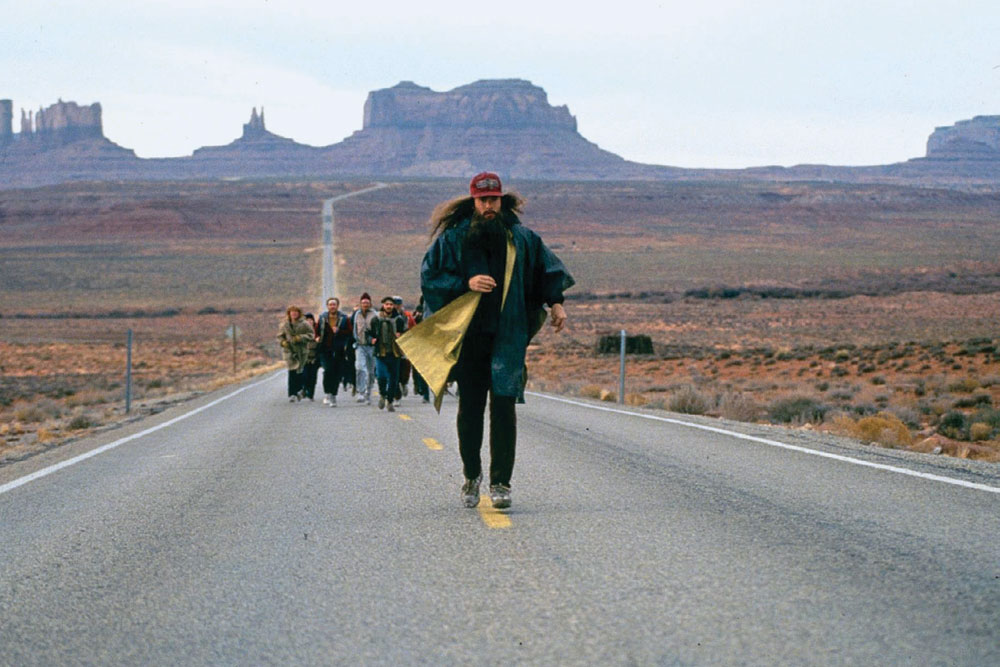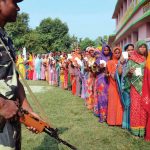A Sledge Across the Personal Tundra
On running, life, and everything in between
 Rahul Pandita
Rahul Pandita
 Rahul Pandita
Rahul Pandita
 |
27 Dec, 2019
|
27 Dec, 2019
/wp-content/uploads/2019/12/Tundra1.jpg)
The author running in Tanot, Jaisalmer, Rajasthan, December 2018 (Photo: Ashish Sharma)
FOR SEVERAL YEARS, ESPECIALLY after I reached my late thirties, I have harboured a secret ambition of being like Caballo Blanco. The former war correspondent Christopher McDougall meets Blanco, or the White Horse, as he is popularly known, in Mexico where he lives in the impenetrable Barrancas del Cobre with the Tarahumara, a tribe whose members are known for their legendary running prowess. The Tarahumara people live a secluded life and amongst those, as McDougall writes in Born to Run, Blanco lives like ‘a ghost among ghosts.’
McDougall spots Blanco in a dim lobby of an old hotel where Blanco arrives wearing only shorts, a pair of sandals and an old baseball cap. He lives in a hut across the mountains and comes every day to the town to visit old ladies (‘mamas’) who feed him beans and tortillas, and beer. That evening he has arrived after running and hiking all day long. He is ‘deliriously hungry’ and polishes off two bowls of beans and three bottles of Tecate beer.
There is a certain charm in a life like that. You live in a place where PM 2.5 and emails and EMIs and AMCs and OTPs do not guide your life. You get up, have a spoon of chia seeds and sprint off with no particular destination in mind. You run because that is what you want to do. And you only stop running when you are hungry, just like Blanco.
That life still remains a distant dream. But I have been pursuing serious running for a long time now. I started running seriously after I turned 30. I have no recollection of what I did on my 30th birthday. But, going by the general trend of my life in those days, I would have been with a friend, or may be even alone, in a bar somewhere. So, how I started running was not a moment as in the life of Dean Karnazes, whose ultramarathon career began on the night of his 30th birthday party. As Peter Sagal writes in The Incomplete Book of Running, Karnazes ‘became so disgusted with himself he stripped to his shorts, started running down the street, and called his wife the next morning from thirty miles away, asking for a pickup.’ I had no such epiphany. But I guess it was something similar. In college, I ran often with a friend. The two of us would get out of our hostel in Chandigarh and start running towards the Rose Garden and then return after stopping over at the local market where we would consume a packet of Verka milk each. I possessed torn white shorts, and canvas shoes, in which I would run with my friend for as long as we wanted to. But, working in Delhi newsrooms demanded that one led a rather mechanical life, where any sign of empathy was seen as a sign of personal weakness. Nobody invested in looking inwards; there was no inner voice, and if there was one, one made no eye contact with it. Remaining lost in chasing mostly senseless news was the only way of staying in the tribe.
The joyful runs of Chandigarh became a thing of the past. But sometimes I would still look at the voice within from the corner of my eyes. That was mostly because I was in love and I kept on nourishing a militant fire inside me to change the world. After a gruelling day of work, in the darkness of my apartment, my mind often went back to a particular scene in Forrest Gump—Tom Hanks is running solo with his long beard, and it appears that a sky with a million colours is running with him, too.
But instead of Forrest, a significant part of my life in those days would be spent in the forests of central and eastern India. I had a personal history of homelessness, and it brought with it anger. That anger often resulted in a thirst for understanding why things happened in a particular way; it also meant that I got consumed by what I became witness to during my incessant travels. I kept most of it to myself; in journalism, I realised, there was not much scope for this imagery.
And then I turned 30 in a blur. Suddenly, I felt a need to take out time to look inwards again, make eye contact with that voice. By this time, I had a faint memory of how I felt during my runs as a young adult. But they were embedded enough in my mind to know that they could help me in my new pursuit. When I looked around, I realised I knew no one who ran seriously. The writers and journalists who were part of my circle had hardly exercised and mostly lived on cigarettes and alcohol. Some had started to go to gym, but it was for losing flab around their bellies.
My mind often went back to Forrest Gump-Tom Hanks is running solo with his long beard, and it appears that a sky with a million colours is running with him too. But instead of Forrest, my life in those days would be spent mostly in the forests of Central and Eastern India
I remember the day when I finally decided that I wanted to run again. But it seemed a very daunting task. Nevertheless, one morning I just got up, wore my old sneakers, and went to the neighbourhood park where mostly old people came for a walk and pass time by rubbing their fingernails as Baba Ramdev had instructed them to. I walked a mile or so and then decided to break into a light jog. I must have lasted a quarter of a mile. I had to stop to catch my breath. The memory of all the cigarettes I had smoked the previous day came back. I walked a bit again and then ran a bit before deciding that it was enough for the day. But something really magical happened as I sat afterwards on a bench. As sweat trickled down my face, a sense of calm washed over me. I closed my eyes and for the first time did not feel afraid to immediately open them right into the world I loathed so much in its ugly manifestations.
The next morning my legs hurt a lot. I had hardly run. But then the memory of that calm came back. I felt that I should have more of it. So, I returned the next morning. In about a month’s time, as I whizzed past people walking slowly, I knew that this was something I would not let go of.
By the time I ran a few marathons, a new running consciousness had taken over all around me. On my timeline, a lot of people I knew began to post pictures of them running a ‘marathon’ (they turned out to be mostly 5 and 10 km runs) and posing with a medal between their teeth. But afterwards, for most, it never became a serious thing.
This is because, much like everything else in life one becomes serious about, running demands a lot of time. The writer Haruki Murakami, who is also a serious runner, calls running both an exercise and a metaphor. ‘Running day after day, piling up the races, bit by bit I raise the bar, and by clearing each level I elevate myself,’ he writes in What I Talk About When I Talk About Running.
If not anything else, running teaches one patience. The biggest mistake many runners around me committed was to try achieving a lot in a short span. They had their own pressures—a marathon event was happening every week in some city or the other, and the lure of putting up a picture of oneself on social media with the medal is too tempting. In that rush, many ended up running too much in too short a time. They end up getting injured after which they quit running altogether. They forgot that the idea is to first build up what is called base miles. It means that you keep running at a pace whereby you can have a conversation with someone who is running next to you. The point, as Martin Dugard explains in To Be a Runner is to reacquaint the body with sustained movement.
Also, many find it difficult to deal with pain. ‘If we do not relate to pain, we are not relating to half our life,’ writes Sakyong Mipham in Running With the Mind of Meditation. After running the Chicago Marathon that he found tough, Peter Sagal walks slowly into the house where his wife confronts him by asking why he subjects himself to such extremes if it hurts so much. To which he responds: “That’s kind of the point.” In an interview with the Olympic runner Toshihiko Seko just after his retirement from running, Murakami asked him: “Does a runner at your level ever feel like you’d rather not run today, like you don’t want to run and would rather just sleep in?” Murakami writes that Seko started at him and then replied (‘in a voice that made it abundantly clear how stupid he thought the question was’): “Of course. All the time!”
Most runners I meet these days say they got serious about running only in their mid-thirties and early forties. It is that time when you want to prove something to yourself more than to others. It surprises me sometimes, personally, how much precedence running takes over my life than anything else.
On my 40th, I agreed to meet my literary agent over breakfast at a market in South Delhi. That morning, I woke up early, put on my running gear and began a slow run towards the Carnatic café where we were supposed to meet. Less than four months earlier, I had run a half marathon in a small town in New Jersey where the temperature was three degrees below zero. The route passed through a beautiful trail where people in the community lined up at several places to cheer on the runners. A group of volunteers kept the trail clean by picking up trash of plastic glasses and Gatorade bottles and GU energy gel sachets. But now I was running in Delhi, where even expecting a vehicle to slow down as you approached it while running was a lost battle.
Sakyong Mipham asks: ‘After you run for a while, what do you find in there but your own mind?’ As I pushed myself on a busy Delhi road, my life that I had lived so far flashed in front of me. I saw the red dioxide floor of my home in Kashmir. I saw a very insecure boy in school moved by the first lines of VS Naipaul’s A Bend in the River. I saw myself selling shaving kits to pay my college fees as a bomb went off nearby, killing the then Punjab Chief Minister Beant Singh. I saw a young man arriving in Delhi in an overnight bus from Jammu who had absolutely no idea what treachery and sorcery he would discover in the new city. I saw myself on the last bus from Raipur to Dantewada, shivering with fever, but hoping to make it on time to meet a Maoist contact for an onward journey of weeks. I saw flashes of a young Maoist guerrilla, her battered feet in the still waters of a river, beyond which was the mythical Abujhmaad of Chhattisgarh. I saw flashes of a man who had mentally remained a child due to some illness and who would rest his head against my shoulder sometimes and close his eyes after his father brought him to a clinic near my college hostel. I saw a friend falling from his bike and breaking his arm as we were returning from the Sunday book market at Daryaganj. I saw a former lover in her room reading Bashir Badr under a table lamp. I saw glimpses of a bar in South Delhi where two men arrived one night with their own bottle of Old Monk, one consoling the other who was distraught because he had become the father of a girl. I had flashes of Carson McCullers by her table in New York, sipping tea and dry sherry from her flask as she wrote The Heart Is a Lonely Hunter.
By the time I broke from this reverie, I was almost there. I looked at the running app on my mobile phone. I had run 24 kilometres.
In the next few years, I drank less and less and smoked only a little. The best runners are those who live a monkish life and abstain from things that will in any way come in the way of their running efficiently. That is why many serious runners I know hang out only with people like themselves. The idea is to have a certain clarity about what running means to you. There is a big difference, as James Clear explains in his book, Atomic Habits, between telling someone who offers you a cigarette that “I have quit smoking” and “I do not smoke.”

I have spent the last few years running and have now added other dimensions like lifting weights to become better at it. I run fast enough to sometimes feel nauseous running in a circle in a sports complex. That is when I head out, like I did last December, when I ran on a long, winding road at Tanot in Jaisalmer, on the Indo-Pakistan border. It surprises me sometimes how much time I spend thinking about running. I am almost becoming like that runner who, to avoid any procrastination, sleeps with her running shoe tied to her ankle.
But, sometimes, runners also become obsessed and turn into a pain for others at social gatherings; they turn into running evangelists. During an event where Matthew Futterman decides to run along his wife, she suddenly tells him that she would like to run alone. It turns out that she had not liked his attempts at inspiration. ‘On one run, as we trekked up Harlem Hill, I told her the only hills that exist are the ones we create in our minds,’ he reminisces towards the end of his book, Running to the Edge. “Oh, fuck off,” she ticks him off. Then she explains that, in fact, they are running up a killer hill.
That is why I personally find it better to run solo. That way, I do not have to wear T-shirts of running groups, nor pose for group post-run pictures, nor engage in conversations that steer me off my own self. No two days are the same. One day you run like a gazelle, the next day your legs turn to lead. But the idea is to show up on the road, take a sledge across our personal tundra. As those immortal lines in The Great Gatsby go: ‘Tomorrow we will run faster, stretch out our arms farther.’
And, who knows, one day, some of us may become our own versions of Blanco.

/wp-content/uploads/2025/06/Cover-OpenMinds2025.jpg)












More Columns
Puri Marks Sixth Major Stampede of The Year Open
Under the sunlit skies, in the city of Copernicus Sabin Iqbal
EC uploads Bihar’s 2003 electoral roll to ease document submission Open